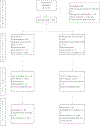Randomized clinical trial of an Internet-based depression prevention program for adolescents (Project CATCH-IT) in primary care: 12-week outcomes
- PMID: 19194326
- PMCID: PMC6290998
- DOI: 10.1097/DBP.0b013e3181966c2a
Randomized clinical trial of an Internet-based depression prevention program for adolescents (Project CATCH-IT) in primary care: 12-week outcomes
Abstract
Objective: The authors sought to evaluate 2 approaches with varying time and complexity in engaging adolescents with an Internet-based preventive intervention for depression in primary care. The authors conducted a randomized controlled trial comparing primary care physician motivational interview (MI, 5-10 minutes) + Internet program versus brief advice (BA, 1-2 minutes) + Internet program.
Setting: Adolescent primary care patients in the United States, aged 14 to 21 years.
Participants: Eighty-four individuals (40% non-white) at increased risk for depressive disorders (subthreshold depressed mood >3-4 weeks) were randomly assigned to either the MI group (n = 43) or the BA group (n = 40).
Main outcome measures: Patient Health Questionnaire-Adolescent and Center for Epidemiologic Studies Depression Scale (CES-D).
Results: Both groups substantially engaged the Internet site (MI, 90.7% vs BA 77.5%). For both groups, CES-D-10 scores declined (MI, 24.0 to 17.0, p < .001; BA, 25.2 to 15.5, p < .001). The percentage of those with clinically significant depression symptoms based on CES-D-10 scores declined in both groups from baseline to 12 weeks, (MI, 52% to 12%, p < .001; BA, 50% to 15%, p < .001). The MI group demonstrated declines in self-harm thoughts and hopelessness and was significantly less likely than the BA group to experience a depressive episode (4.65% vs 22.5%, p = .023) or to report hopelessness (MI group of 2% vs 15% for the BA group, p = .044) by 12 weeks.
Conclusions: An Internet-based prevention program in primary care is associated with declines in depressed mood and the likelihood of having clinical depression symptom levels in both groups. Motivational interviewing in combination with an Internet behavior change program may reduce the likelihood of experiencing a depressive episode and hopelessness.
Figures




References
-
- Kessler RC, Walters EE. Epidemiology of DSM-III-R major depression and minor depression among adolescents and young adults in the National Comorbidity Survey. Depress Anxiety. 1998; 7(1):3–14. - PubMed
-
- March J, Silva S, Petrycki S, et al. Fluoxetine, cognitive-behavioral therapy, and their combination for adolescents with depression: Treatment for Adolescents With Depression Study (TADS) randomized controlled trial. Jama. 2004;292(7):807–820. - PubMed
-
- Wilcox-Gok V, Marcotte DE, Farahati F, Borkoski C. Early onset depression and high school dropout In: Marcotte DE, V W-G, eds. The Economics of Gender and Mental Illness. Amsterdam: Elsevier; 2004.
-
- Bramesfeld A, Platt L, Schwartz FW. Possibilities for intervention in adolescents’ and young adults’ depression from a public health perspective. Health Policy. December 2006;79(2–3):121–131. - PubMed
Publication types
MeSH terms
Grants and funding
LinkOut - more resources
Full Text Sources
Medical

